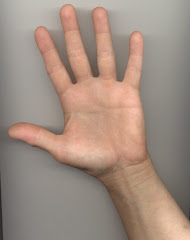 This work spent time as a "warm-up" painting in the studio. What that means, essentially, is that now and then it ended up on the easel those times when I wasn't quite ready to paint on any of the in-progress works. I usually have about two or three works that are in the "warm-up" category. These paintings get painted, scraped down, repainted, over-worked, under-worked, and generally pushed around until I'm either tired of them or something suddenly clicks and I end up with a "keeper" instead of an addition to the discard box.
This work spent time as a "warm-up" painting in the studio. What that means, essentially, is that now and then it ended up on the easel those times when I wasn't quite ready to paint on any of the in-progress works. I usually have about two or three works that are in the "warm-up" category. These paintings get painted, scraped down, repainted, over-worked, under-worked, and generally pushed around until I'm either tired of them or something suddenly clicks and I end up with a "keeper" instead of an addition to the discard box.Early on, I titled this "Goose Woman." Originally this title referred to the figure's ample thighs combined with a "pigeon-toe-like" stance. At that point, the birds were sandhill cranes. The scene was evening/moonlight because at the time I was painting plenty of night/moonlit landscapes, so this allowed me to test out colors or approaches without worrying about messing up one of the works in-progress. Warm-up paintings seldom make it to "finished work" status because of this process. But day before yesterday, "Goose Woman" clicked and so now it has a lovely pale yellow mat and awaits a frame.
I've found that "Goose Woman" is a difficult work to photograph. Outdoors in natural diffused light (north side of my studio) it takes on more blue than it actually is. Indoors it becomes very warm-toned with sepia and honey yellow tones. The photo above is as close as I can get to the actual color of the work. There is a slight glare visible in the upper left from the overhead lamp.
The detail photo at the right shows the overall tonal quality the painting takes on when placed under incandescent light. I think under this light it reminds me of some of Renoir's romantic female figurative works.
The golden highlights in the hair fall beyond the hair into the reeds and read as fireflies.
Below is the painting, with matting, on my framing table. I even like this work upside down! The painting is about 12 by 22 inches. Outside dimension of the mat is 19 by 29 inches.
So, now the question is: Do I keep this work in my "studio collection" of works that still speak to me at some level, or do I offer it for sale at Etsy? And if so, then what price to place on it? "Goose Woman" is truly a "one of a kind" among my studio works, so with nothing to compare it to (other than size) it is not as easily priced as other paintings are.
Readers, please comment with your thoughts. Thanks!


















